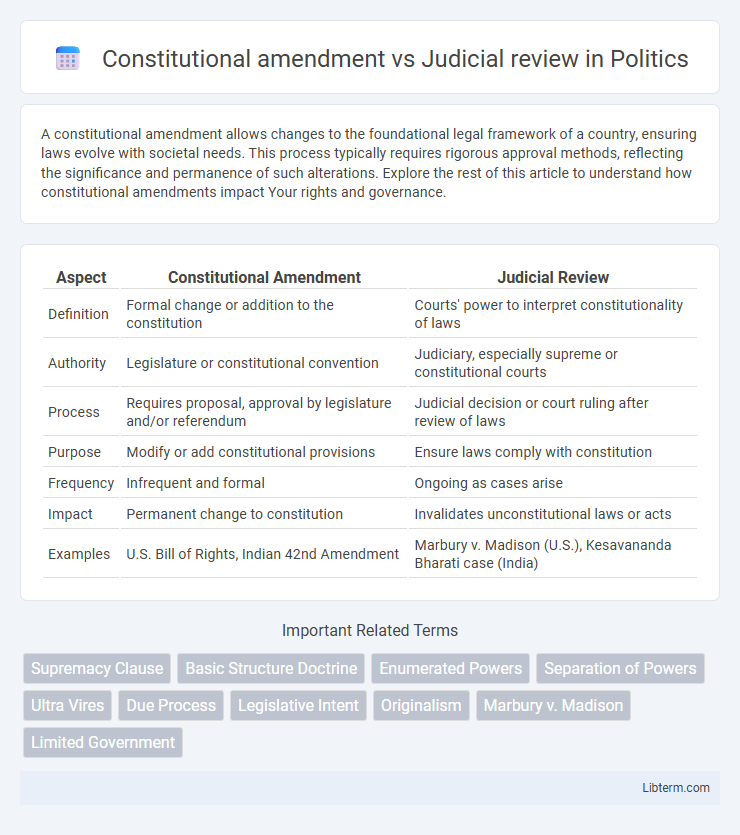A constitutional amendment allows changes to the foundational legal framework of a country, ensuring laws evolve with societal needs. This process typically requires rigorous approval methods, reflecting the significance and permanence of such alterations. Explore the rest of this article to understand how constitutional amendments impact Your rights and governance.
Table of Comparison
| Aspect | Constitutional Amendment | Judicial Review |
|---|---|---|
| Definition | Formal change or addition to the constitution | Courts' power to interpret constitutionality of laws |
| Authority | Legislature or constitutional convention | Judiciary, especially supreme or constitutional courts |
| Process | Requires proposal, approval by legislature and/or referendum | Judicial decision or court ruling after review of laws |
| Purpose | Modify or add constitutional provisions | Ensure laws comply with constitution |
| Frequency | Infrequent and formal | Ongoing as cases arise |
| Impact | Permanent change to constitution | Invalidates unconstitutional laws or acts |
| Examples | U.S. Bill of Rights, Indian 42nd Amendment | Marbury v. Madison (U.S.), Kesavananda Bharati case (India) |
Introduction: Defining Constitutional Amendment and Judicial Review
Constitutional amendment refers to the formal process of altering or adding provisions to a constitution, typically requiring legislative approval and often a public referendum to ensure legitimacy. Judicial review is the authority of courts, especially constitutional or supreme courts, to interpret the constitution and invalidate laws or government actions that conflict with constitutional principles. Both mechanisms serve as fundamental tools for maintaining constitutional governance, with amendments enabling structural changes, while judicial review ensures ongoing constitutional compliance.
Historical Context: Evolution of Constitutional Amendments
The evolution of constitutional amendments reflects a formal process allowing legislatures or referenda to adapt foundational laws to changing societal needs and values, tracing back to early examples such as the United States Constitution's Bill of Rights (1791). This legislative mechanism contrasts with judicial review, where courts interpret constitutional provisions and can invalidate laws conflicting with constitutional principles, a power famously asserted in Marbury v. Madison (1803). Over time, the dynamic between amendment processes and judicial review has shaped constitutional development globally, balancing democratic amendment flexibility with judicial safeguards of constitutional integrity.
The Origins and Development of Judicial Review
Judicial review originated in the early 19th century with the landmark U.S. Supreme Court case Marbury v. Madison (1803), establishing the judiciary's authority to invalidate laws conflicting with the Constitution. This principle emerged to maintain the supremacy of the Constitution and ensure that legislative and executive actions remain within constitutional bounds. Over time, judicial review evolved as a fundamental mechanism for constitutional interpretation and safeguarding individual rights against legislative overreach.
Constitutional Amendment: Process and Procedures
The constitutional amendment process involves formal procedures established by a country's constitution, typically requiring legislative approval by supermajorities or ratification through referenda. This process ensures that changes to the fundamental legal framework reflect broad consensus and safeguard democratic principles. Unlike judicial review, which interprets the constitution, amendments directly alter or add constitutional provisions through structured legal mechanisms.
Judicial Review: Mechanisms and Scope
Judicial review allows courts to assess the constitutionality of legislative acts and executive decisions, ensuring alignment with constitutional principles. Mechanisms include the power of constitutional courts or supreme courts to invalidate laws that conflict with the constitution, serving as a check on legislative and executive branches. The scope of judicial review varies by jurisdiction but generally covers statutes, regulations, and administrative actions impacting fundamental rights and governance structures.
Key Differences: Constitutional Amendment vs Judicial Review
Constitutional amendment is a formal process involving legislative approval to change or add provisions to the constitution, while judicial review allows courts to interpret and invalidate laws conflicting with the constitution. Amendments reflect the will of the legislature or referendum, creating binding changes, whereas judicial review serves as a check on legislative and executive actions by ensuring constitutional compliance. The amendment process typically requires supermajority votes or ratification by states, contrasting with judicial review, which is exercised by judicial authorities through case rulings.
Complementary Roles in Constitutional Governance
Constitutional amendments enable democratic adaptation by formally altering the foundational legal framework through legislative or popular processes, ensuring legal evolution aligns with societal values. Judicial review empowers courts to interpret and uphold the constitution, safeguarding against unconstitutional laws and government actions, thereby maintaining constitutional integrity. Together, these mechanisms provide a complementary system that balances democratic change and legal stability within constitutional governance.
Landmark Cases: Judicial Review Shaping Constitutional Law
Marbury v. Madison (1803) established the foundation of judicial review, empowering courts to invalidate unconstitutional legislative acts and profoundly shaping American constitutional law. The Supreme Court's decisions in Brown v. Board of Education (1954) and Roe v. Wade (1973) demonstrate judicial review's role in advancing civil rights and individual liberties by interpreting constitutional principles. Constitutional amendments require formal legislative processes, whereas judicial review allows courts to adapt constitutional meanings dynamically through landmark rulings.
Challenges and Controversies Surrounding Both Concepts
Constitutional amendment processes face challenges such as political polarization and rigid procedural requirements that can hinder timely legal reforms, raising debates over democratic legitimacy and adaptability. Judicial review encounters controversies involving accusations of judicial activism and overreach, where courts are perceived as policymakers rather than interpreters of law. Both concepts spark tensions regarding the balance of power between legislative bodies and the judiciary, impacting constitutional stability and democratic accountability.
Conclusion: Impact on Democracy and Rule of Law
Constitutional amendment empowers citizens and legislators to directly shape and update the legal framework, reinforcing democratic principles and ensuring laws reflect contemporary societal values. Judicial review acts as a safeguard by allowing courts to invalidate unconstitutional laws, thus protecting individual rights and maintaining the balance of power. Together, these mechanisms uphold the rule of law by blending popular sovereignty with judicial oversight, promoting a resilient and adaptable democratic system.
Constitutional amendment Infographic

 libterm.com
libterm.com